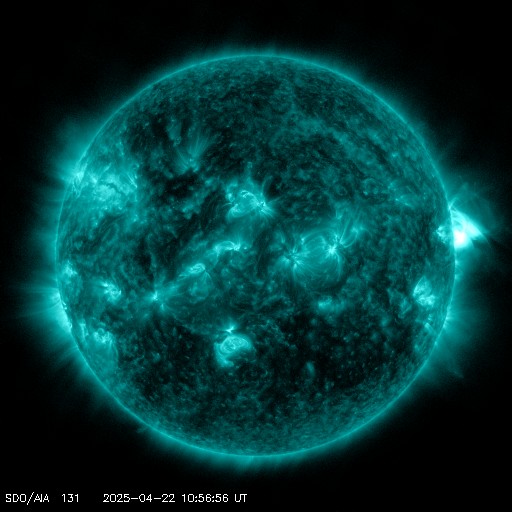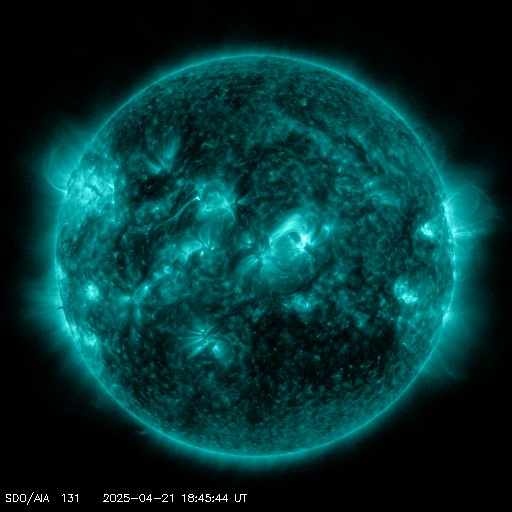Viewing archive of Saturday, 24 April 2004
Solar activity report
Any mentioned solar flare in this report has a scaling factor applied by the Space Weather Prediction Center (SWPC). Because of the SWPC scaling factor, solar flares are reported as 42% smaller than for the science quality data. The scaling factor has been removed from our archived solar flare data to reflect the true physical units.
Report of Solar-Geophysical Activity 2004 Apr 24 2200 UTCPrepared by the NOAA © SWPC and processed by SpaceWeatherLive.com
Joint USAF/NOAA Report of Solar and Geophysical Activity
SDF Number 115 Issued at 2200Z on 24 Apr 2004IA. Analysis of Solar Active Regions and Activity from 23-2100Z to 24-2100Z
Solar activity was moderate. Region 597, which has
rotated beyond west limb at latitude S08, produced an M1 flare at
23/2112 UTC. The region produced numerous additional C-class flares
through around 1400 UTC, but is now behind the limb. Newly numbered
Region 599 (N14E51) emerged on the disk and grew steadily. The
region had an area of 120 millionths with mature penumbra on the
leader and trailer by the time of forecast issue (24/2200 UTC). The
group has been producing frequent upper level B-class and lower
level C-class flares. Region 596 (S09W21) continues to be the
largest group on the disk but was stable and appears to be decaying.
IB. Solar Activity Forecast
Solar activity is expected to be low.
Region 599 is expected to be the most productive group, although
Region 596 might contribute some activity. There is a slight chance
for an isolated M-class event sometime during the next three days.
IIA. Geophysical Activity Summary 23-2100Z to 24-2100Z
The geomagnetic field was mostly quiet to unsettled. There was an
isolated active period at high latitudes between 0900-1200 UTC.
Solar wind speed remains slightly elevated with values running
between 420 to 480 km/s.
IIB. Geophysical Activity Forecast
The geomagnetic field is
expected to be mostly unsettled with a chance for isolated active
periods at high latitudes for the next 24 hours (25 April).
Conditions should decline to mostly unsettled levels at all
latitudes for the second and third days.
III. Event Probabilities 25 Apr to 27 Apr
| Class M | 20% | 20% | 20% |
| Class X | 01% | 01% | 01% |
| Proton | 01% | 01% | 01% |
| PCAF | green | ||
IV. Penticton 10.7 cm Flux
Observed 24 Apr 112 Predicted 25 Apr-27 Apr 115/115/120 90 Day Mean 24 Apr 107
V. Geomagnetic A Indices
Observed Afr/Ap 23 Apr 016/020 Estimated Afr/Ap 24 Apr 010/013 Predicted Afr/Ap 25 Apr-27 Apr 012/015-012/012-010/010
VI. Geomagnetic Activity Probabilities 25 Apr to 27 Apr
| A. Middle Latitudes | |||
|---|---|---|---|
| Active | 25% | 25% | 20% |
| Minor storm | 20% | 20% | 15% |
| Major-severe storm | 10% | 10% | 05% |
| B. High Latitudes | |||
|---|---|---|---|
| Active | 30% | 30% | 25% |
| Minor storm | 25% | 25% | 20% |
| Major-severe storm | 15% | 15% | 10% |
All times in UTC
Currently there's no noteworthy space weather
Latest news
Latest forum messages
Filaments and prominences 92AR4070 8Space Weather Memes 695Unspecified geomagnetic activity 2315Incoming & Unnumbered Active Regions 1803
More topicsSupport SpaceWeatherLive.com!
A lot of people come to SpaceWeatherLive to follow the Sun's activity or if there is aurora to be seen, but with more traffic comes higher server costs. Consider a donation if you enjoy SpaceWeatherLive so we can keep the website online!

Latest alerts
Tuesday, 22 April 2025
11:09 UTC - Solar flare
Moderate M1.35 flare
10:39 UTC - Radio Blackout
Minor R1 radio blackout in progress (≥M1 - current: M1.03)
Monday, 21 April 2025
20:45 UTC - Geomagnetic activity
Minor G1 geomagnetic storm (Kp5) Threshold Reached: 20:33 UTC
18:57 UTC - Solar flare
Moderate M1.99 flare
18:39 UTC - Radio Blackout
Minor R1 radio blackout in progress (≥M1 - current: M1.93)
Space weather facts
| Last X-flare | 2025/03/28 | X1.1 |
| Last M-flare | 2025/04/22 | M1.3 |
| Last geomagnetic storm | 2025/04/21 | Kp5+ (G1) |
| Spotless days | |
|---|---|
| Last spotless day | 2022/06/08 |
| Monthly mean Sunspot Number | |
|---|---|
| March 2025 | 134.2 -20.4 |
| April 2025 | 121 -13.2 |
| Last 30 days | 113 -27.2 |





